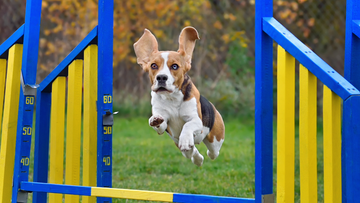Training your dog to do agility is a fun and rewarding way to strengthen your bond and improve their overall well-being. Agility is a fast-paced sport where dogs navigate obstacle courses, including jumps, tunnels, and weave poles, with their handler. If you want to compete or just want a new activity for you and your dog, this step-by-step guide will help you get started!
Step 1: Basic Obedience Skills

Before you introduce your dog to agility obstacles, it must have a solid foundation in basic obedience. Commands like sit, stay, come, and heel are important parts of navigating an agility course. These commands will help ensure that your dog listens to you even when it is excited or distracted. If your dog doesn’t have these basic commands down yet, spend some time practicing these behaviors in different environments.
Step 2: Introduce Agility Obstacles Slowly
Once your dog has mastered basic commands, you can introduce agility obstacles. Start with easy obstacles like jumps and tunnels. First, it’s best to use low, adjustable jumps and short, open tunnels to build confidence.
- Jumps: Use a pole that can be set at a low height. First, walk your dog over it with a leash to encourage it to jump over it. Slowly increase the height and remove the leash as your dog becomes more comfortable.
- Tunnels: At first, use a short tunnel and coax your dog through it with treats or a toy. Make sure to give them lots of praise when they successfully run through it!
Step 3: Weave Poles and Contact Obstacles
As your dog gains confidence with the basics, you can move on to more challenging obstacles, such as weave poles and contact obstacles, like the A-frame and dog walk.
- Weave Poles: Start by spacing the poles far apart so your dog can walk through them. Use a treat or toy to guide your dog through the poles, rewarding it as it gets through. Over time, reduce the space between poles until your dog can weave through independently.
- Contact Obstacles: These require your dog to touch certain points on the equipment, usually at the beginning and end, like the A-frame, seesaw, and dog walk. Start with low heights and encourage your dog to walk slowly. Give them a lot of praise and treats for touching the contact points!
Step 4: Practice Handling Skills
Agility isn’t just about your dog’s ability to complete the course; it’s also about how well you both communicate and work together as a team. As the handler, you must guide your dog through the course using verbal commands, body language, and hand signals. Practice simple drills where you guide your dog around one or two obstacles at a time. Focus on your timing and communication to help your dog understand where to go next.
Step 5: Build Courses
Once your dog is comfortable with individual obstacles, you can start building small courses with 2-4 obstacles. Start with simple sequences like a tunnel followed by a jump. As your dog becomes more experienced, gradually increase the difficulty by adding more obstacles and different combinations.
Step 6: Join an Agility Class
If you’re serious about teaching your dog agility, consider signing up for a local agility class. This will allow you and your dog to practice with the guidance of experienced instructors. It will also give you access to professional equipment, enabling you to practice in a controlled environment with other dogs.
Agility training is an awesome way to keep your dog physically active and mentally stimulated. It also strengthens the bond between you and your dog as you navigate a course together. By starting with basic obedience, gradually introducing equipment, and focusing on clear communication, you’ll be well on your way to mastering agility!






















